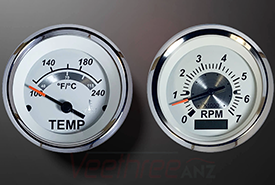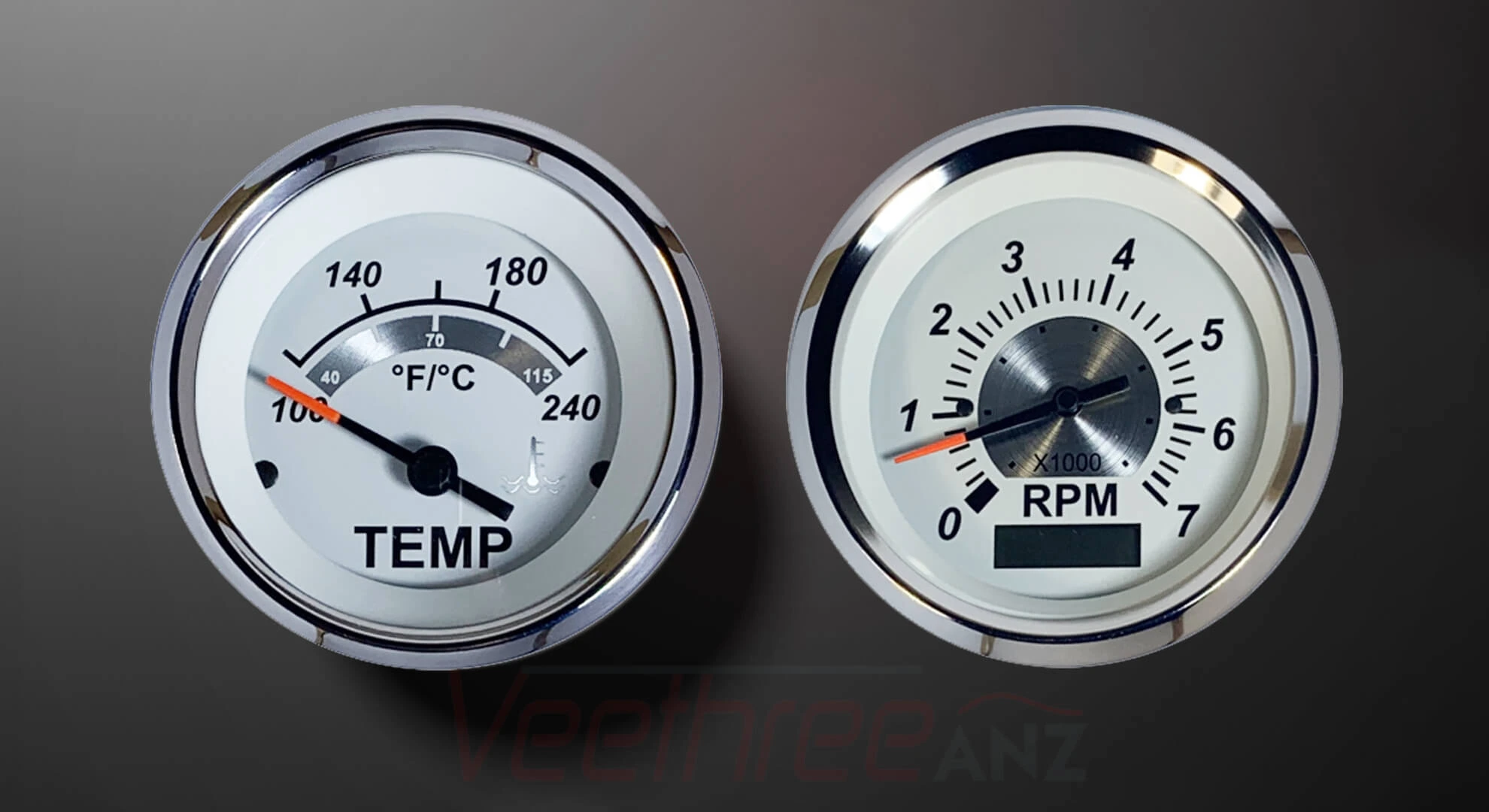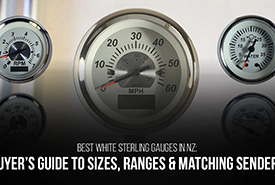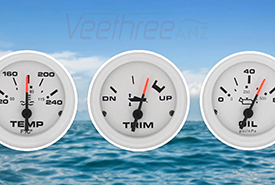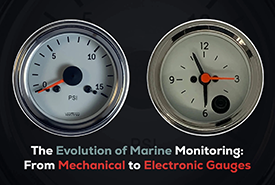- Free shipping for NZ Customers. All items are available in NZ warehouse
- +64 (0) 212576146
- [email protected]
White Sterling Gauges Buyer’s Guide: Sizes, Ranges & Sender Pairings

Mechanical Gauges in Diesel Applications: Pulsation Damping & Vibration Mounts
September 17, 2025
Arctic Gauges Installation Best Practices: Visibility, Lighting & IP Ratings
October 1, 2025If you’re upgrading a dash or sorting a fresh fit-out, the one thing you can’t wing is matching gauge ranges with the right senders. Do that well and everything reads true. Miss it, and you’ll chase ghosts on the water. This guide walks you through White Sterling Gauges, how they’re sized, what ranges they come in, and—most importantly—how to nail sender curve compatibility so your readings are spot on.
Why boaters keep picking White Sterling Gauges
The White Sterling Gauges line blends a clean white face with polished stainless bezels and through-dial lighting, so you get crisp readability day or night. They bring a classic look without skimping on modern performance, which is why they’re a favourite on tidy refits and new builds.
What you’ll find across the range:
- 52mm gauges for the common auxiliaries—fuel, oil pressure, water temperature, voltmeter. These sit neatly in standard cut-outs and keep the dash balanced. In the White Sterling Gauges sets, the auxiliaries are 52 mm and ship with the matched senders where required.
- Big dials for key readouts: an 86mm GPS speedometer and an 85mm tachometer in the mix, so you can read the essentials at a glance.
- Marine-ready construction: corrosion-resistant bezels, scratch-resistant lenses, and illumination for low-light runs.
Sizes at a glance (keep this handy)
- 52mm gauges: fuel gauge 240–33 ohm, oil pressure gauge 0–80 psi, water temperature gauge 100–240 °F, voltmeter 8–18 V.
- 85mm tachometer: 0–7000 RPM, programmable for common configurations.
- 86mm GPS speedometer: 0–200 km/h version (plus mph options) and supplied with a GPS receiver.
- Combination option: pitot speedometer with integrated fuel gauge in an 86 mm package.
The big idea: choose-the-right-range with sender curve compatibility
Every electrical gauge expects a specific input curve. Match the sender curve to the gauge, and your readings track the real world. Mismatch them, and the pointer lies.
Fuel: the famous 240–33 ohm system
Most White Sterling Gauges fuel instruments use the 240–33 ohm sender curve (high resistance at empty, low at full). The dedicated troubleshooting sheet lays it out clearly: about 240 Ω empty, ≈100 Ω half, ≈33 Ω full. The quick bench test is dead simple—open circuit reads below empty, sender shorted to ground reads above full.
For the White Sterling fuel kits sold locally, the fuel sender adjustable 7–24 inches deep uses the SAE 5-hole mounting pattern (71 mm flange). Pair this sender with a 240–33 ohm fuel gauge and you’re set.
Prefer non-swing reed switch fuel sender styles? Veethree offers reed units in 240–33 ohm and 10–180 ohm variants, so again, choose the curve that matches the gauge.
Temperature: American vs European resistance standards
Electrical coolant temperature systems also follow standard curves. Veethree publishes both:
- American standard: 287–39 ohms across the operating range
- European standard: 134–23 ohms across the operating range
The White Sterling water temperature gauge 100–240 °F sold in ANZ includes a matched sender (1/8-27 NPT) plus adaptors, so the curve is already sorted for you—just use the included sender and don’t mix-and-match with a different brand’s curve.
Oil pressure: match the ohms and the thread
The oil pressure gauge 0–80 psi ships with its matching sender (1/8-NPT). Use the bundled sender and you’ll avoid the common curve mismatch that makes low-range pressure look fine until warm, then drift. Veethree also manufactures pressure senders in both American and European resistance ranges, so if you’re replacing a sender later, match it to the actual gauge curve.
Volts, speed and trim
- voltmeter 8–18 V is straightforward—no sender needed. Fit, wire, and go.
- GPS speedometer with receiver: White Sterling sets include a GPS puck with the 86mm GPS speedometer; there are also mph variants if you prefer.
- trim gauge options are engine specific. White Sterling trim gauges are sold as trim gauge for Honda outboards and as variants for Mariner Mercury Volvo Yamaha—pick the one that suits your engine family.
Quick pairing cheat-sheet
Fuel- Use 240–33 ohm gauge with 240–33 ohm sender
- If using a reed switch fuel sender, make sure the ohm curve matches the gauge face
- Standard SAE 5-hole mounting for the float-type senders supplied in local kits
- Adjustable to 7–24 inch tank depth (kit senders)
- water temperature gauge 100–240F ships with matched sender 1/8-27 NPT and adaptors—use the one in the box
- If you ever replace the sender separately, confirm you’re buying the American 287–39 ohm or European 134–23 ohm curve to suit your gauge
- oil pressure gauge 0–80 psi includes the pressure sender; keep the matched pair together
- Replacement senders are available in American and European ranges—verify before purchase
- voltmeter 8–18 V: direct connection, no sender curve to worry about
- 86mm GPS speedometer: use the supplied GPS receiver, or choose an mph model if that suits your setup
- Order the trim gauge variant that explicitly lists your engine family (e.g., trim gauge Honda outboards)
How to choose the right range in three steps
- Start with the job, not the dial
Decide what you need to see while underway. For most trailer boats, oil pressure gauge 0–80 psi, water temperature gauge 100–240F, and voltmeter 8–18V cover the essentials without clutter. If you cruise by speed limits in km/h, the GPS speedometer 200 km/h is a natural pick; if you think in mph, grab the 60 mph or 120 mph version. - Lock in the curve
For any electrical gauge that needs a sender—fuel, oil pressure, water temp—the sender must match the gauge’s ohm curve. For fuel, that’s usually 240–33 ohm on White Sterling; for temperature and pressure, use the matched sender provided, or match the American/European standard exactly if replacing. - Check fit and threads
White Sterling kits take the guesswork out by including the correct senders and adaptors (for example, temperature sender 1/8-27 NPT plus common NPT adaptors). Fuel senders supplied with sets are adjustable 7–24 inches and use SAE 5-hole mounting. Confirm your tank depth and thread types before cutting holes.
Pro tips
- Do the two-minute fuel test before blaming the sender. Key on, sender wire removed: gauge sits below empty. Short the sender terminal to ground: gauge moves above full. If it sweeps cleanly, the gauge is fine—look at wiring, earth, or the sender.
- Grounds matter. A floating or missing earth makes a fuel gauge read empty; a shorted sender reads permanently full.
- One gauge per sender. Fuel rheostat senders are designed to drive a single gauge reliably; for dual displays you’ll need the correct wiring approach or a different solution.
- Mind orientation. Install a swing-arm fuel rheostat upside-down and the gauge reads backwards. It’s more common than you’d think.
- Use the senders in the kit. The ANZ White Sterling Gauges sets ship with properly matched senders for fuel, oil, and water temp. Sticking with the supplied parts is the simplest way to guarantee sender curve compatibility.
Popular White Sterling Gauges picks (and why)
- GPS speedometer 200 km/h: dead-steady readings without a pitot tube, supplied with a receiver, tidy installation.
- 85mm tachometer: easy to program across common engine configurations, large face for quick checks.
- fuel gauge 240–33 ohm with adjustable sender 7–24 inches: suits a wide range of tanks and uses a standard SAE 5-hole mounting.
- water temperature gauge 100–240F with matched sender and adaptors: solves the curve question out of the box.
- oil pressure gauge 0–80 psi with matched sender: right range for petrol inboards and many outboards using remote pickups.
- trim gauge variants for your engine family: order the right one—trim gauge Honda outboards, or options for Mariner Mercury Volvo Yamaha—so the scale aligns with the sensor.
Common pitfalls to avoid
- Mixing curves: pairing a 10–180 ohm sender with a 240–33 ohm fuel gauge guarantees nonsense readings. If you must replace a sender, verify the ohms on both sides. (Veethree builds senders in both American and European ranges across categories.)
- Assuming every “52 mm fuel sender” is the same: you’ll see reed switch fuel sender and rheostat styles in 240–33 ohm and 10–180 ohm—they look similar but behave differently.
- Ignoring thread specs: most supplied temperature senders are 1/8-27 NPT and often ship with adaptors; pressure senders are commonly 1/8-NPT too. Don’t force a mismatch—use the included adaptors or order the correct thread.
- Skipping the simple tests: the fuel test above saves hours. Do it first.
A word on style and readability
If you’re chasing a timeless cockpit look, White Sterling Gauges deliver that bright, neat aesthetic that plays well with alloy and fibreglass dashboards. The faces are clean, the pointers are easy to spot, and the lighting is built for night work—no squinting, just quick decisions.
Putting it all together
Choose your dial sizes so the big numbers sit where your eyes fall—86mm GPS speedometer and 85mm tachometer front and centre, 52mm gauges flanking them. Lock in your ranges: oil pressure gauge 0–80 psi, water temperature gauge 100–240F, voltmeter 8–18 V, fuel gauge 240–33 ohm. Then make the curves match—sender curve compatibility is the whole game. If you’re buying a White Sterling set from Veethree ANZ, you’ll get the matched senders and mounting hardware, which removes the guesswork.
When you wire it up, test the fuel gauge with the quick open/short trick, confirm all grounds, and call it a day. It’s a tidy install, it reads true, and the dash looks the part.

